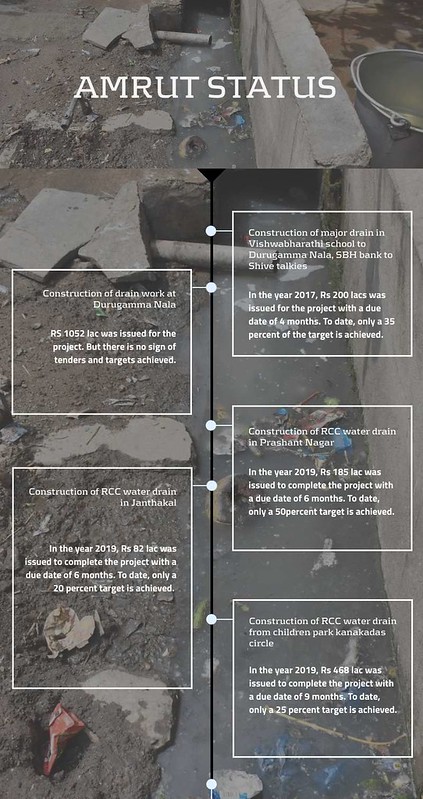Despite being promised better sanitation facilities, the people of Gangavathi are stripped off of their basic rights.
Though sanitation and health care is an important part of living, the locals are robbed of these basic necessities.
“Our condition is really poor. The drains and the roads are in a faulty condition and it’s not just the problem of our slum, but the whole town faces the same issue. Further, kids suffer a lot because they have to endure diseases like dengue, after being bitten by mosquitoes,” said 75-year-old Shyamad Ali, who has been a resident of the slum for years now. “These days getting admitted to a hospital is not economically reasonable, especially for poor people like us who do not have the money to bear the cost,” he added.
In June 2015, Atal Mission for Rejuvenation and Urban Transformation (AMRUT) was unveiled by Prime Minister Narendra Modi with an emphasis on developing facilities capable of ensuring adequate and efficient sanitation networks, water supply for urban development through the introduction of urban revival projects.
It covers all the towns and cities with a population of more than 1,00,000, as per the 2011 census. Gangavathi is one of the 27 cities that is eligible for the funding of the AMRUT scheme in Karnataka.
Under the AMRUT scheme, the people are assured with well-maintained drainage and sewage systems but are in reality, they are divested of it.
Hussain Bi, another slum resident said, “The drains have been clogged for as long as I remember. Several times, I have tried to cut both sides of the drain for the water to flow properly, but it does not help. We fall sick due to mosquito bites. I was hospitalized for a month due to malaria and was on medication. No authorities come to help us, even after numerous complaints.”
“The Nagar Palika does not get the drains cleaned regularly. The authorities visit once in a blue moon and get the drains cleaned just for the sake of it,” said Happi Krishna, resident of a slum. “The drains are full of mosquitoes and it gets difficult to sleep during the night because of it,” Krishna added.
The Ministry of Housing & Urban Affairs allocated Rs 16,00,00,000 for water supply in Gangavathi, along with sewage, drainage, and transportation works that are expected to complete in the next three years.
Due to delays in projects, the condition in which the residents of Gangavathi have to live is miserable. Lack of proper drains in front of the houses, schools, and anganwadis adds to the cause of various diseases in the town. Between 2018 and 2019, there has been an 18 percent increase in malaria cases in Gangavathi.
Dr. Ashwin, Taluk Health Officer said, “For a long time now, stagnant water has been an issue here. The malaria department uses fogging machines to reduce the cases.”
There is a lack of hygiene awareness among the slum dwellers, according to the officer. “We conduct different awareness programs to try and take care of their health. We also visit schools and Anganwadis once every six months and conduct awareness campaigns. We also provide free health care services in our hospital,” Dr. Ashwin said.
The budget allocated for AMRUT for the year 2020-21 is around 35 percent more than 2019, around Rs 9,800 crore.
Ashish Shetty, DMA Engineer said, “We had a shortage of engineers earlier but now after the consultations with DMA, new engineers have been appointed. Even the Bypoll elections took place in between, which cause the delay. Now the current situation due to coronavirus is very unpredictable. Earlier we thought the projects will be completed by this year but now it is difficult to say.”
Tenders for drainage and stormwater drains were passed in 2017 with a year given for the fulfillment of the projects, but the delay continues. Only a few projects have been completed since the date of the issue.
Srinivas, an urban planner said, “Rural areas must learn the lesson now. People have misconceptions about drainage systems, the foremost usage of a drainage system is for rainwater harvesting. Other kinds of drainage systems are sewage and sanitation. In that aspect lot of improvement can be done as technology has improved. There are a lot of schemes for toilets in rural areas but no proper drainage systems can be seen.”
The negligence of the government has deprived the people of basic sanitation facilities. The people of Gangavathi still live in hope that the government will meet their hopes and provide them with better facilities, which was promised to them.




